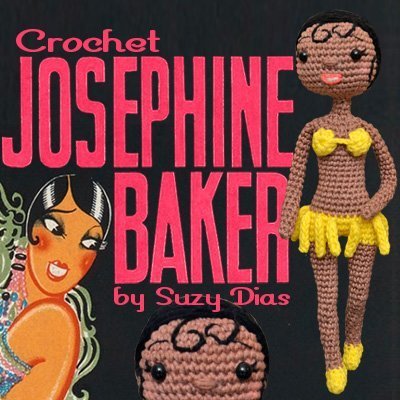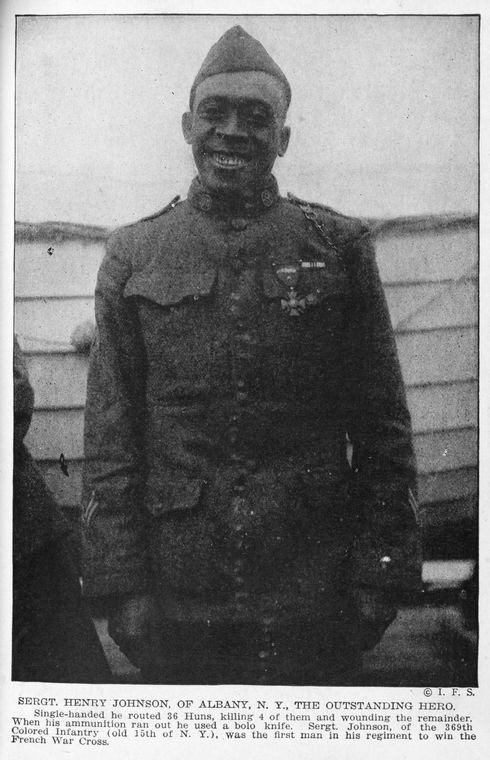Crochet Harlem Hellfighters 369th Regiment
African American Heroes of History
I am devoting some time to creating amigurumi of my favorite entertainers and historical figures. My first undertaking was a crochet Josephine Baker (click here). She was an entertainer, civil rights activist, war hero and mother. She broke racial barriers throughout her life and never lost her warmth and sense of humor.
Where can I buy a Harlem Hellfighter or Josephine Baker?
You can order from my shop through a secure PayPal connection. I will be adding to my new Crochet Heroes of History series. What do the Harlem Hellfighters have in common with Josephine Baker? They all won the French Croix de Guerre for distinguished acts of heroism during World War I and World War II, respectively.
★ Handmade Crochet Harlem Hellfighter
★ Handmade Crochet Josephine Baker
The Harlem Hellfighters
These brave African Americans and Puerto Ricans proved (yet again) that color is a construct used to keep people separate. The 369th Regiment showed the world that not only were they equal, but better. They fought for democracy even while they themselves lived in a segregated apartheid system in the U.S. They hoped their efforts would improve their situation back home, but unfortunately that battle would take a few more decades.
Who were the Harlem Hellfighters?
“We did not give ourselves our name [the ‘Harlem Hellfighters’],” says Col. Reginald Sanders, a former commander of the 369th Sustainment Brigade, which descended from the original World War I unit. “Our enemies gave us our name, [which] is an honor.” [click here to read more…]
“As many as 350,000 black US soldiers were sent to France after the United States joined the war in April 1917. Segregated in the US, they were placed in “coloured” regiments by white officers. The French army suffered a shortage of soldiers from the spring of 1918, but they convinced American generals to provide additional troops, after initial opposition.
“For the US military command, blacks weren’t to participate in the ‘glory’ of fighting,” said Francois Cochet, professor of history at the University of Metz. “They didn’t want to see any coloured soldiers within their ranks so they lent them to the French army, who were less racist as they were used to having soldiers from their colonies,” he said. “The black American soldiers were quite surprised by the way they were treated. French racism was not as strong as American apartheid,” he said.
The regiment was honoured by the French government for its acts of bravery, receiving the Croix de Guerre and the Legion d’Honneur. The regiment included Lieutenant James Resse Europe, the only African-American officer to fight on the frontline.
Europe was also a prominent jazz musician and formed the “Hellfighters jazz band”. Between battles, his group performed concerts to distract troops. [click here to read more…]
“On a clear, cold morning in February 1919, the 369th Infantry regiment – a segregated African-American combat unit – returned to New York from France. The most decorated black soldiers of the First World War, they had served for 191 unbroken days in the trenches, a longer time than any other US troops. And they had done so without conceding a foot of ground to the Germans or losing a man to capture. The valour of the Harlem Hellfighters, as the Germans called them, was uncontestable.”
Among their ranks was Henry Johnson, one of the first Americans of any colour to win the highest French honor, the Croix de Guerre with gold palm and bronze star in 1918. Honoured with a victory parade along Fifth Avenue when they returned to the U.S., the Hellfighters were cheered on by a crowd of 250,000.” [click here to read more…]
“The 369th Infantry Regiment, formerly known as the 15th New York National Guard Regiment, was an infantry regiment of the New York Army National Guard during World War I and World War II. The Regiment consisted mainly of African Americans, though it also included a number of Puerto Rican Americans during World War II. It was known for being the first African American regiment to serve with the American Expeditionary Forces during World War I. Before the 15th New York National Guard Regiment was formed, any African American that wanted to fight in the war had to enlist in the French or Canadian armies.[2] The regiment was nicknamed the Black Rattlers. The nickname Men of Bronze nickname was given to the regiment by the French.[3] The nickname Harlem Hellfighters was given to them by the Germans due to their toughness and that they never lost a man through capture, lost a trench or a foot of ground to the enemy.” [click here to read more…]

Wartime poster of the 369th fighting German soldiers, with the figure of Abraham Lincoln above
Who was Henry Johnson?
Henry Johnson suffered 21 wounds and rescued his friend and fellow soldier, Needham Roberts, while repelling an enemy raid in the Argonne Forest in 1918.
“Privates Henry Johnson and Needham Roberts, from Trenton, New Jersey, were given French helmets, French weapons and enough French words to understand commands from their superiors…
Was he popular during his life?
Absolutely! He was a bona fide American hero. Upon his discharge the Army used Johnson’s image to recruit new soldiers and to sell Victory War Stamps. (“Henry Johnson licked a dozen Germans. How many stamps have you licked?”)
Former President Theodore Roosevelt called Johnson one of the “five bravest Americans” to serve in World War I.” [click here to read more]
However, life is often cruel and the cheering didn’t last for long.
“They came home to some of the worst racial violence in American history, the Red Summer of 1919,” Brooks explains. “I don’t think there’s been that level of race riots that we’ve seen in American history.”
Brooks adds there was a tremendous amount of pushback against African-American soldiers once they returned to civilian life.” [click here to read more…]
Crochet Harlem Hellfighter
OK, enough with the history lesson. I was so inspired by their heroism that I started to crochet and created my version of a Harlem Hellfighter.
The biggest challenge was the uniform. I’ve never created a soldier before, nor have I attempted a uniform this complex. Each element – from the boots, to the side cap to the utility belt – was a puzzle. And what type of expression should he have? I had more questions than answers, but as with every new project, I had fun working through them all. I took some liberties with the boots, but I liked the additional detail (the real Hellfighters covered their laces). After a few versions, many hours and a lot of love, I settled on this. I hope you like him too!
To buy a Handmade Harlem Hellfighter
Please visit my shop for more photos and to order:
★ Handmade Crochet Harlem Hellfighter
★ Handmade Crochet Josephine Baker
» To contact me with any questions, please click here.
Read more about the Harlem Hellfighters…
• WWI’s Harlem Hellfighters Who Cut Down Germans and Gave France Jazz
• Remembering Henry Johnson, the Soldier Called “Black Death”
• The Harlem Hellfighters: Fighting Racism In The Trenches Of WWI












